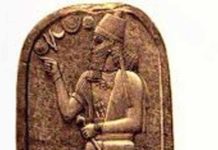Judges 1:8.21 tells us of the Israelites attempt to take Jerusalem from the Jebusites. They did not succeed and it wasn’t until David’s time that Jerusalem became home to the Israelites. In 997 BCE, Jerusalem became the centre for David’s people. It became the capital of the United Kingdom of Israel. (2 Sam 5:6-9, 1 Chron 11:4-7)
David and Solomon
The Jebusites slowly integrated and became part of the Jewish People. The city grew slowly, first expanding to the north and then to the west. The oldest part of Jerusalem can be found on the crest of Ophel. In 960 BCE, David’s son, King Solomon began building the First Temple in order to house the Ark of the Covenant.
Solomon began building a palace north of the old Jebusite city and had a new wall built to enclose this new development (1 Ki. 7:1-8, 9-24). During the reigns of David and Solomon, the city of Jerusalem seemed to become a permanent home for the Hebrews. Peace had followed the administration of David and Solomon, and the inhabitants of Jerusalem now thought of it as their permanent home.
Rehoboam
Rehoboam, Solomon’s successor, was a weak leader, and during his reign, the Kingdom divided and the northern tribes established their own state, which they called the Kingdom of Israel. Rehoboam’s southern alliance became the Kingdom of Judah, with Jerusalem as its capital. (1 Kings 12-14).
These two factions fought continuously over the next fifty years, thus making them an easy target for Egyptian rule. Pharoah Shishak moved up through the Negev, attacked Judah and Jerusalem. Judah now lost control of the route to the trading ports of the Red Sea, as Israel blocked access to Phoenician ports on the Mediterranean, so the overland caravans and maritime commerce no longer contributed to Jerusalem’s wealth.
Kings Omri, Ahab, Jehoshaphat, Amaziah and Uzziah.
The northern tribes and their fortunes or misfortunes, had an important effect on Jerusalem. For example, when King Omri of Israel made Samaria his capital, he needed to retain peace with Judah to ensure safe passage to the coast. His successor, Ahab, ended the war with Judah and its king, Jehoshaphat. King Jehoshaphat brough Judah and Jerusalem back to prosperous times, only to be destroyed by King Amaziah of Judah who warred with Israel.
King Uzziah began a fortification plan of Jerusalem and mended the fences between Judah and Israel, and the two kingdoms soon ruled from the southern tip of the Negev, up to the borders of Phoenicia on the coast and Damascus in the desert – it was a prosperous time for Jerusalem.
Hezekiah
In 744 BCE, Assyria attacked Israel and Judah and eventually occupied most of northern Israel and exiled thousands of inhabitants to Upper Mesopotamia and Media. Jerusalem thus became Abraham’s people’s sole national headquarters. It was under King Hezekiah that Jerusalem rose to great heights. Sennacherib, the new Assyrian ruler, was making his way south and Jerusalem was an obvious target.
Hezekiah was determined to secure the city’s weakest point which was the water conduit through which David and his men had crept many years before. Hezekiah succeeded in blocking any access from outside the walls and ensured there was a good water supply inside the city. Hezekiah also rebuit many walls and fortifications and the Temple was repaired. Sennacherib struck in 701 BCE, but Jerusalem did not fall.
Nebuchadnezzar
In 586 BCE, Nebuchadnezzar II destroyed Jerusalem and the Temple. He blinded and exiled King Zedekiah and exiled all the Jews to Babylonia. Jerusalem was not rebuilt as a walled city until the time of Nehemiah. When Cyrus the Great of Persia conquered Babylonia, the Jews were allowed to return to Jerusalem and began rebuilding their Temple. Jerusalem was in Persian hands until 333 BCE.
The books of Ezra and Nehemiah give us a history of Israel at this time. The narrative of Ezra 1-6 tells of events from the restoration until the rebuilding of the Temple. While Ezra 7 and Nehemiah 13 offers an account of the reforms and general moral climate of Judah in the time of Ezra and Nehemiah. It was important at this time, mid-fifth century BCE, for the Persians to have peace in the regions so that the Egyptians could be carefully monitored.
The Greeks
In 333 BCE, Alexander the Great conquered Palestine, amongst many other states. Greek culture spread across the map. In 323 BCE, Jerusalem came under Ptolemy I of Egypt. when Ptolemy V was defeated in 198 BCE by the Seleucids, Syria and Palestine came under their rule and Jerusalem again became a pawn of empires. The next destruction of Jerusalem came in 168 BCE and was executed by Antiochus. He built a Syrian garrison which controlled the city until 141 BCE.
The Romans
In 63 BCE and 54 BCE, the Romans entered the city. It was plundered by a Parthian army in 40 BCE and Herod took control of Jerusalem in 37 BCE. Herod glorified and beautified the city of Jerusalem by building palaces, temples and fortifications befitting a king. He built his central palace in the city and rebuilt the Hasmonaean citadel and built three multi-storied towers. Herod also enlarged and embellished the Temple.
The Zealot Revolt
The Zealot revolt of AD 66-70 with Rome culminated in Titus destroying the walls and fortifications in Jerusalem. By August/September AD70, the Temple had been reduced to ashes and many of Jerusalem’s inhabitants had either been massacred or had starved to death.
Source:
- The Holy Bible. King James Version







